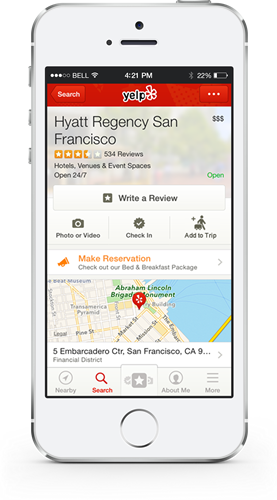
Using Yelp to plan your next trip.
Imagine using your favorite review and restaurant finder to completely research, plan, and book your next trip. Store photos and memories to share with family & friends.
Role
UX Design
Team of 4
Timeframe
2 weeks
Skills
User Research, Usability Testing, Visual Design
Software
Illustrator, Fireworks, Axure RP
![]()
![]()
![]()
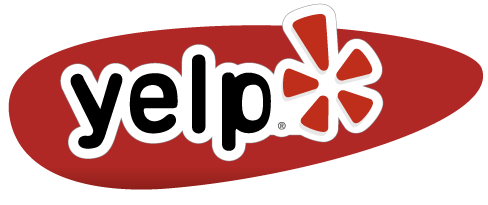
Background
Yelp provides both free and paid business listings to businesses of all sizes and types. Yelp also enables businesses to deliver targeted search advertising to large local audiences through its website and mobile app. Yelp offers both graphic and text display advertisements on its website and mobile app which are sold on a per-impression basis. Through multiple partnerships made by Yelp, The Yelp Platform allows consumers to complete food delivery transactions, book spa and salon appointments, and make hotel bookings and winery reservations, all without leaving the app or website.
New Ideas
People use Yelp to find everything from restaurant reviews, information on local businesses, hotels, local attractions, etc. What if Yelp wanted to expand their offerings to be the go-to place for travelers planning trips: a mobile feature that would allow users to create plans for their travels and the have the ability to record their actual experiences.
Yelp is currently seen by users as a “here and now” advisory service. “Let’s find a great place for drinks tonight.” It does this exceedingly well. Expanding its offering to help users to create trip itineraries allows Yelp users to more deeply invest in the service.

Research
The ability to plan a trip goes beyond Yelp’s current “list” and “bookmark” features. The ability to plan and schedule items is a new feature and we therefore wanted to ensure we had carefully explored not just what would be involved in the new feature, but also who else was doing it… and who was doing it well.
Yelp’s top competitor in this area is TripAdvisor, very well known for its hotel, travel and vacation planning reviews and booking services. Other competitors include Zaggat, Foursquare, and UrbanSpoon. It should also be noted that Yelp has partnered with certain hotels and services like Hipmunk to allow people to book hotels from within the Yelp Platform.
Competitors
![]()
![]()
![]()
![]()
![]()
Research Stage Deliverables
User Interviews
(scripts, notes, & release forms)
Organizational Research
Affinity Diagrams
Cardsort Categories
Task Analysis
User Flow Diagram
Heuristic Evaluation
Competitive & Comparative Analysis
Project Summary
Competitive Analysis / Task Analysis
We performed a Competitive/Comparative Analysis with Yelp’s major competitors. The analysis helped us learn about the features offered by each company as well as strengths and weaknesses. Where similarities existed, we also performed a task analysis to objectively rate the number of steps and make subjective notes about ease of use.
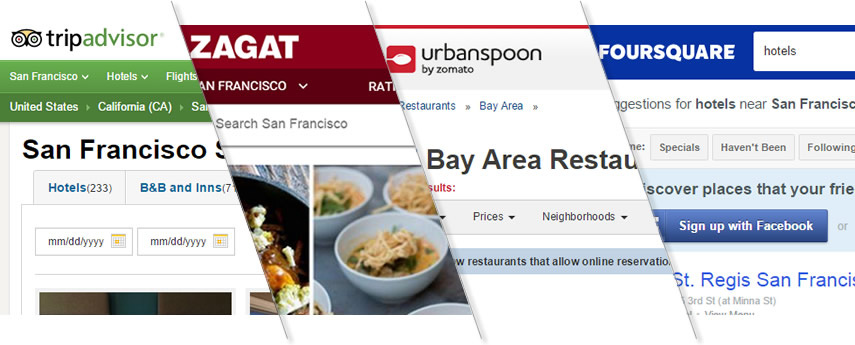
User Interviews
Our pre-interview work involved assembling screening questions, a script, and consent forms.
After the interviews, our team reassembled and compared notes. To see what users were thinking, we began to create affinity diagrams and card sort categories which were then then sent out to users for additional testing.
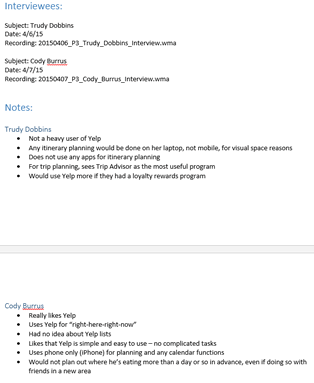
Affinity Diagrams
Creating affinity diagrams helped us learn about patterns in the qualitative data we gathered from the interviews. Post-it notes served as our medium for brainstorming and organizing the information based on “I” statements from the users’ point of view (e.g. “I would look here…”).
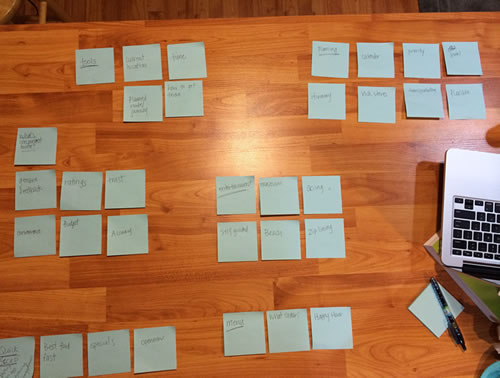
Card Sort Categories
We used Optimal Sort by Optimal Workshop to create and distribute card sort category tests. The dendogram (at right) allowed us to visualize correlations in the data and learn how users would best sort, find, or use items related to trip planning.
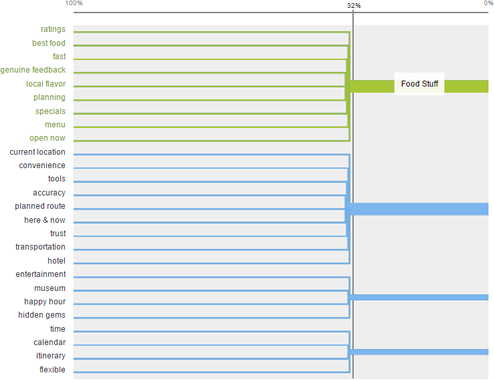
The cart sort category results helped us stay in tune with the user’s mental model… where would they expect to find things.
Planning
All the research starts coming together through numerous eraserboard discussions. The project is brought to life with the development of our persona, development sketches, storyboards, and user flows.
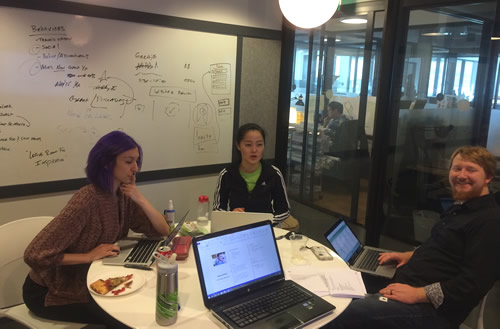
Planning Stage Deliverables
Customer Journey
Persona
Storyboarding
Scenarios
Use Cases
User Flows
Persona Development
Empathy is key in any user experience design project. We took our real-world observations and contextual inquiry to develop our persona, Patrick. He embodied the types of behaviors of real users in a narrative and goal-oriented fashion.
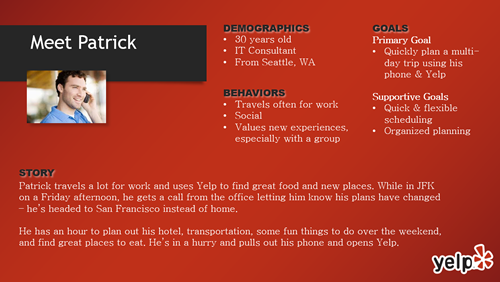
Storyboards
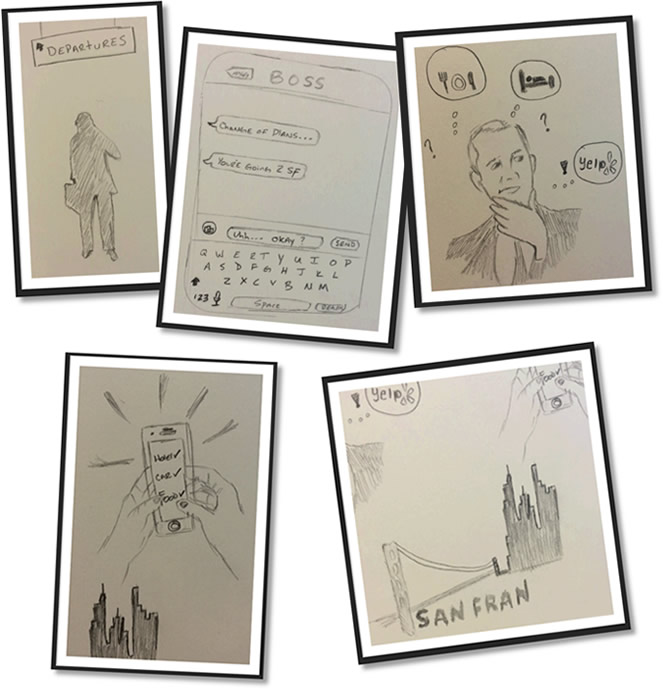
Usability Testing
Our Balsamiq wireframes were then put out to the test. We performed five studies with eight participants in each group. Balsamiq was a great tool for this, again because of minimal investment in product creation. We were able to quickly iterate, update our script and questions and perform another test.

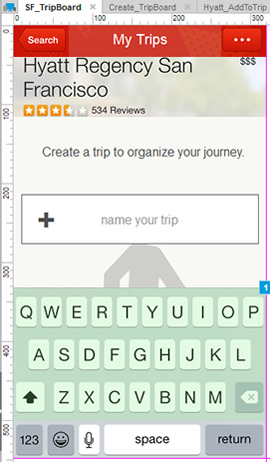
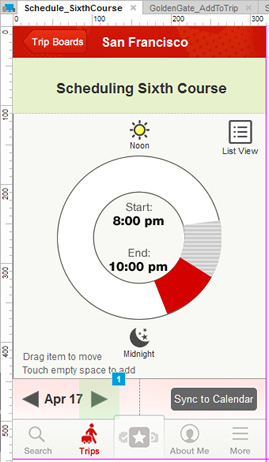
Prototype Deliverable
More Research
This was a great project and it left me with even more ideas to iterate on! I’d like to experiment with various icons for the Trip Planner. Most of Yelp’s icons are more simple, and our person with a suitcase didn’t fit 100% with other, more simplistic logos. However, in initial testing, other logos like a suitcase seemed unclear to most users. I’d like to do more testing on this.
The scheduler was a huge can of worms that I’d like to unwrap more. We did numerous iterations and wanted to test out a radial timepiece instead of the normal iOS date picker. I plan on pursuing this further!
Round 2

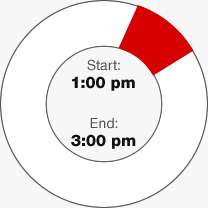
Retrospective
It’s always good to ask questions like what worked, what didn’t, and what would I try to remember for next time.
Something that worked really, really well for our team was doing “Design Studios.” There were several instances where we just hit an impasse or were simply talking way too much. That meant it was time to stop talking and start drawing. Each person spent 5 minutes sketching a solution. We would time-box 2 minutes for each one to share their ideas. The team selected the best one and if needed, sketched again for another 5 minutes, then shared. This got us past many stumbling blocks!
